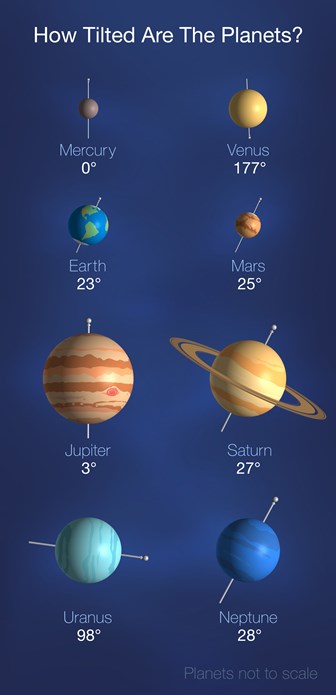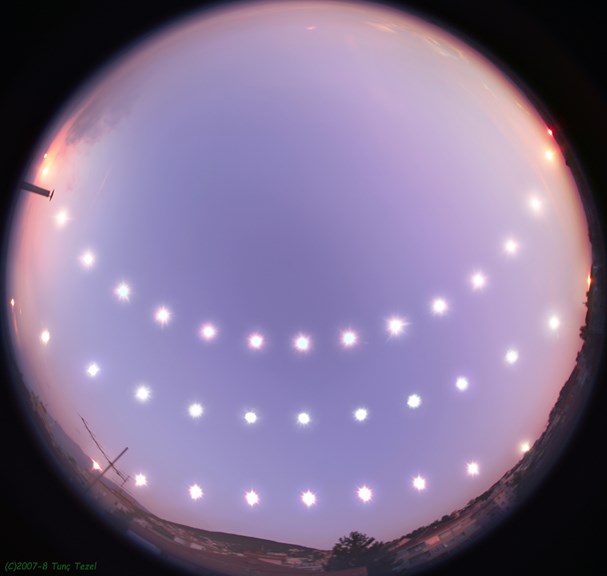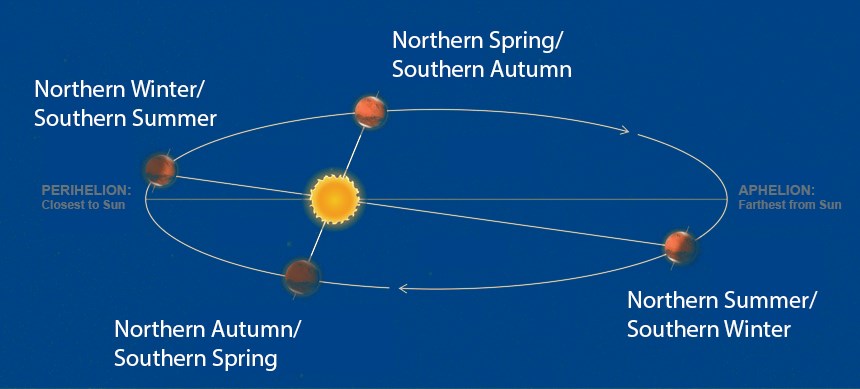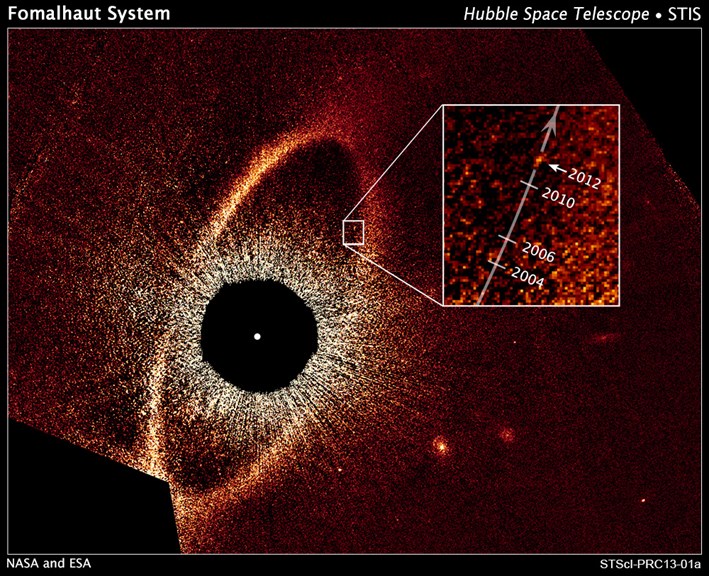Skynotes: September 2021
Spring Equinox
We begin slowly tilting towards summer with days and nights of almost equal length.
Online events
Delve into space tourism and venturing off-world in our Astro Hour webinars for families and adults in September. Join Scienceworks astronomer nearly-Dr Sara Webb and educator/science nerd Douglas Bair online.
Equinoxes or why tilt matters!
Days in the southern hemisphere are starting to slowly warm as we move to Spring Equinox. The word equinox comes from the ancient Latin aequinoctium (equal night) and medieval equinoxium - a period twice a year when day and night are effectively the same length. It is also referred to as the Vernal Equinox from the Latin ver for spring-time, a period of new growth.
Spring is a convenient time to remember how equinoxes and the seasons in general come about. It’s all about the tilt. We’ll look at the fundamentals, some other planets, how tilts actually come about, and end with a thought experiment to reflect upon. Peppered in this month issue are links to explore the various things we will cover.
Here’s a quick interplanetary teaser to begin with….
Other planets can have seasons too. Mars has equinoxes and seasons too and as a planet it is often compared to Earth with a similar lean and day length, despite being further from the sun with a much longer year.
Now back to Earth, globally the equinox will be on Thursday 23rd and marks the end of winter and the beginning of spring in the southern hemisphere (or end of summer and start of autumn in the northern hemisphere). At equinoxes the sun shines directly on the equator and both hemispheres receive equal amounts of daylight.
It is often said that day and night are equal on the equinox, but this is not quite so. Only the centre of the Sun is above the horizon for 12 hours, making our day slightly longer at 12 hours and 8 minutes. Not only does the day start with the first appearance of the Sun, but there’s another strange effect occurring as well. The Earth’s atmosphere bends light from the Sun so that at sunrise we are able to see the Sun before it physically crosses the horizon. The reverse occurs at sunset, we continue to see the edge of the Sun for several minutes even though it has already sunk below the western horizon.
However, the actual date of equal day and night for any given location is dependent on its latitude. For Melbourne’s latitude of 37.8 degrees south it will be September 19th, a few days before the equinox, with sunrise at 6:14am and sunset at 6:13pm.
At latitudes away from the equator the explanation for equinoxes and the main reason for the seasons lies in our planet’s titled axis of rotation which is effectively fixed at 23.5 degrees with respect to its orbit around the sun. This means that in spring and autumn neither hemisphere leans towards the sun as in summer, nor away as in winter.

Image credit: NASA/JPL-Caltech/Richard Barkus
But an obvious question is how does a planet large or small, terrestrial or gas giant, come to rotate with an axis that is tilted? Research into circumstellar dust clouds, solar system formation and various theories of planetary systems suggests that in a vast interstellar cloud gas molecules, dust grains and bigger objects are moving in different directions but in general around a central protostar that is forming. As they collide forming planetesimals, and they in turn merge, an increasingly larger protoplanet forms in orbit around its parent star. Their combined energy of motion is a net gain in angular momentum which gives the young planet its spin. This accretion under gravity gives the young planet its rotation. Its axis may be ‘vertical’ (at a right angle to its orbital path) or tilted to some degree depending on what future impacts it undergoes or the gravitational influences it comes under from other bodies in the new planetary system.
A leading theory has the young Earth colliding itself in an early period of formation with a smaller planetoid dubbed Theia, one of the many objects hurtling around the young solar system. Formed from the resultant debris was our large moon which is proportionally larger than any moon around a planet in the solar system except for Charon and Pluto. Such a big moon may well have stabilised our planet’s tilt with only a very small wobble or precession over a 26,000 year period. This effect is due to Earth being an oblate spheroid (wider around the equator that a perfect sphere would be), and tidal forces caused by the gravitational influence of moon and sun.
For our terrestrial neighbours things are quite different. By comparison, Mars at about half Earth’s size, one tenth its mass and with two small moons, has a current tilt of 25 degrees but which apparently can change significantly over long timescales. Venus, however, presents us with a conceptual challenge as it rotates ‘backwards’, perhaps from a collision that flipped it over, and could therefore be said to be tilted at either 3 degrees or 177 degrees!
Here back on Earth during spring or autumn the tilt means that for latitudes away from the equator the sun’s rays strike the ground obliquely, not at the steep angle of summer which gives greater energy per square metre, or the shallow one of winter which provides less energy. And in these regions the tilt brings the sun’s daily path in the sky to midway between summer’s when it is high and long (for more daylight hours) and winter’s when it is low and short (for fewer daylight hours).

Image Credit: APOD / Tunc Tezel / TWAN
Equinox thought experiment
What would our world be like if it was not tilted? Imagine no equinoxes. No seasons. No spring or autumn. No summer or winter. Perhaps no primordial Theia collision. What would it be like if day and night were always equal? For any particular latitude, the sun’s rising and setting points, its path across the sky, and how high it reaches above the horizon (local solar noon), would be the same every day of the year.
Weather affects us profoundly and results from many local and regional factors such as solar radiation, land cover, vegetation, sea, clouds, snow and rain. But with no tilt and no equinoxes what variations might there be? Would our planet’s climate be radically different? Polar regions would still be cold, temperate regions mild, and the tropics warm. Earth’s orbit is slightly elliptical which brings the planet a little closer to the sun and a little further away over the course of a year, but this is a minor influence so it may not be relevant. However, in a world not tilted a significant difference would be a change to an even intensity of solar radiation at each given latitude.
We are beginning to understand better that Earth has a global system of interconnected processes and feedbacks that link lithosphere, hydrosphere, biosphere, atmosphere, magnetosphere and the near space environment. Would no tilt mean big changes to atmospheric circulation, storm activity, rainfall, snowfall, evaporation, desertification, ocean salinity and currents, polar ice cover, glaciation, erosion and many other forces?
Would life and the behaviour and distribution of animals, plants and ecosystems be the same?
And finally, to complete our speculation about what it might be like if Earth was not tilted, as a species would our human cultures be altered? Would we have developed other ideas or attitudes? Would our civilisation view the world and the universe in other ways?
Explore more at these websites:
Melbourne sun times
| Date | Rise | Set | Day length | Solar noon§ |
|---|---|---|---|---|
| Wed 1 | 6:42 | 5:58 | 11:16 hrs | 12:20 |
| Sat 11 | 6:27 | 6:07 | 11:40 hrs | 12:16 |
| Tue 21 | 6:11 | 6:15 | 12:04 hrs | 12:13 |
| Tue 30 | 5:57 | 6:23 | 12:25 hrs | 12:10 |
§ When the Sun is at its highest, crossing the meridian or local longitude
Moon phases and distances
| Phase | Date |
|---|---|
| New Moon | Tue 7 |
| First Quarter | Tue 14 |
| Full Moon | Tue 21 |
| Third Quarter | Wed 29 |
This month’s Moon perigee (closest to Earth) is on Sat 11th at 368,461 km and apogee (furthest from Earth) is on Mon 27th at 404,640 km.
Planets
Mercury is visible very low in the west during dusk. At the start of the month it can be seen from 6.25pm before setting around 7.50pm. At mid-month it will be visible later at 6.40pm and set by 8.20pm. By the end of the month it will effectively be lost in the glare of the sun.
Venus will can also be seen low in the west at dusk. It will be far brighter than Mercury and easily seen. Early in the month it will be visible from 6.20pm and set by 9.10pm. Mid-month it will appear from 6.25pm before setting by 9.40pm. At the end of the month the ‘evening star’ can be seen from 6.40pm until it sets around 10.00pm.
Mars is very close to the sun this month. It will have set by evening twilight and be very difficult to see. The Red Planet will pass behind the sun over the next few months and reappear in mid-January in the east as a early morning object before sunrise.
Jupiter continues to rise in the east mid-afternoon becoming visible high in the east at around 6.30pm. It will be bright as it rises to its highest position in the north by 10.30pm and remain visible in the west until about 4.30am.
Saturn rises a little earlier in the afternoon than Jupiter. It too can be seen high in the east from around 6.40pm and will reach its highest northern position at 9.20pm and remain visible until 3.30am as it moves to the west.
Meteors
While not a good time for meteors this month the Southern Piscids will peak from 11th to the 20th. They usually number only a few per hour and appear in the constellation of Pisces, the fish, which rises in the north-west from midnight.
Stars and Constellations
In the north
High in the north is Aquila (the eagle) with its principal star Altair (Alpha Aquilae), the 12th brightest star at night and 17 light years from us.
Low in the north lies Lyra (the lyre of Orpheus in Greek myth) and Vega (Alpha Lyrae) which is 25 light years away and 5th brightest star at night.
In the east
Low in the east this month is Aquarius (the water bearer) and above lies Capricornus (the goat). A little to the right (towards the east-south-east) is Piscis Austrinus (Southern Fish) which has as its principal star Formalhaut (Alpha Piscis Austrinus), 25 light years away and the 18th brightest star at night.
In 2013 in a vast dust ring observed around Formalhaut a planet was discovered. With the star’s glare blocked out in this image the ring is clear and the faint planet Formalhaut-b is revealed:
In the south
Now lower in the south-west is the smallest of the 88 constellations agreed upon by astronomers in 1930 - Crux, or the Southern Cross. Nearby and a little higher sit the Two Pointers (Alpha and Beta Centauri) which are the brightest and second brightest stars in the constellation of Centaurus. Alpha Centauri is also known as Rigel Kentaurus (‘foot of the centaur’) and is the 4th brightest star in the night sky. It marks our nearest star system at 4.3 light years comprising three stars and at least two planets. See last month’s Skynotes for more on this amazing neighbour.
The 10th brightest star and 144 light years distant Achernar (in the constellation of the Eridani, the river) is lower in the south-east this month. In the south is the 2nd brightest star Canopus at 313 light years sitting in Carina (the keel). From Melbourne’s latitude these two bright stars are circumpolar and never set below the horizon.
In the west
Virgo and Spica (Alpha Virginis), the 15th brightest star at night and 262 light years away, are now lower in the west. Arcturus, the 3rd brightest star at night and 37 light years, has also moved lower to the north-west with the constellation Bootes (the herder or plower).
High in the west lies Libra (the scales) leading even higher up in the evening to Scorpius marking a curving line of stars with one of its central three the red giant Antares (Alpha Scorpii) at 34 light years and 16th brightest star at night.
Moving directly overhead to the zenith is the centaur Sagittarius. Its bow and arrow can easily be made into the asterism known as The Teapot.
A little lower to the south-west lies Corvus (the crow) with Hydra (the sea serpent) passing around to reach towards Libra (the scales) high in the west.
First peoples night sky
In Victoria and across Australia there has been thousands of years of night sky observing and story-telling in rich and diverse traditions. The features of the night sky have cultural meaning and important connection to the origin of things, the land and its people, the seasons and all the flora and fauna of this ancient continent.
Celebratory coins been struck to mark our First Peoples night sky, and a study has been done on kindred connections in astronomy. Both are covered on The Conversation.com.
New Coins features their artists and Wiradjeri and Yamaji designs which include Nyarluwarri (Seven Sisters) and Gugurmin (The Emu).
Kindred Skies explores what similarities there might be to ancient Greek constellations of hunters, birds, canoes and twins.
As mentioned last month, from the Wardaman tradition of Northern Territory the 5th brightest star in the Southern Cross (Epsilon Crucis) has been named Ginan. And with Scorpius at the zenith this month you should also be able to see the 5th brightest star in that constellation (Epsilon Scorpii) which is now named Larawag.
See new star names in Australia and from other cultures around the world.
The giant emu continues its night sky appearance in the dark dust clouds of the Milky Way that stretches around the sky. Be sure to look from a location well away from city lights. Its head is the Coal Sack beside the Southern Cross. From there follow its neck through the Two Pointers. And then go across to Scorpius, Antares and Larawag as large dark regions in these areas are its body and long legs.
International Space Station
At a distance of about 400km the ISS completes an orbit every 90 minutes and appears as a bright point slowly moving across the night sky. Here are some of the brightest passes expected this month over Melbourne:
Evening
- Fri 3: 7.43pm–7.46pm South-West to South-South-West
- Mon 6: 6.59pm–7.06pm South-West to North-East
Morning
- Thu 23 5.36am–5.43am West-North-West to South-East
- Fri 24 4.51am–4.56am North-West to South-East
Heavens Above gives predictions for visible passes of space stations and major satellites, live sky views and 3D visualisations. Be sure to enter your location under Configuration.
On this day
1st 1939, Americans J Robert Oppenheimer and Hartland Snyder publish the first paper that describes the gravitational contraction of a star which later led to the modern concept of black holes.
1st 1859, Carrington Event, most powerful geomagnetic storm ever recorded. Now understood as a Coronal Mass Ejection (CME) from the Sun that hit Earth’s magnetosphere inducing strong northern auroras almost to the equator, and telegraph interference in Europe and North America with operators receiving electric shocks, poles sparking, and signals sent despite power cut off.
1st 1979, Pioneer 11 (USA) made the first flyby of Saturn returning the first close-up images of the planet. It was the second probe to pass the asteroid belt and Jupiter and to reach solar escape velocity. Last routine contact was on 30 September 1995 and final data received was on November 1995.
5th 1977, Voyager 1 (USA) is launched to explore the outer Solar System. After 42 years it continues sending data and is the most distant probe at 21.8 billion km (146 AU). It entered interstellar space in 2012 and its power supply may last until 2025.
8th 2004, Genesis (USA) probe crashes in Utah while returning samples of solar wind particles. Some collecting panels survived impact and were recovered giving successful scientific results.
11th 1985, the International Cometary Explorer or ICE (USA) became the first spacecraft to encounter a comet by flying through the dust tail of Comet Giacobini-Zinner.
14th 1959, Luna 2 (USSR) was the first craft to fly to and impact another body, in this case the Moon. It released sodium gas to allow visible tracking, used radio for telemetry transmission, and crashed into Mare Imbrium (the Sea of Rains).
17th 1976, NASA unveils its concept for a Space Transportation System, a rocket launched and glider return orbiter known as the Space Shuttle.
17th 1857, birth of Konstantin Tsiolkovsky, a pioneering Russian then Soviet teacher whose theoretical work on aerodynamics and rocketry influenced all who followed. He advocated spaceflight and believed humans would colonise the galaxy.
18th 1977, Voyager 1 (USA) sends the first image of Earth and Moon together taken, from a distance of 11.6 million km while on its way to Jupiter.
21st 1633, the Roman Catholic Inquisition begins its trial of Galileo for heresy in publishing and advocating a heliocentric or Sun-centred solar system contrary to church doctrine, dogma and scripture.
23rd 1846, Neptune, first predicted by Urbain Le Verrier (France), is discovered by Johanne Gottfried Galle (Germany) with John Couch Adams (UK) recognised for an independent discovery.
27th 1905, Albert Einstein published his paper containing the famous equation E=mc2 (energy equals mass multiplied by the speed of light squared), meaning a small amount of matter is equivalent to, or can be converted into, a great deal of energy.

